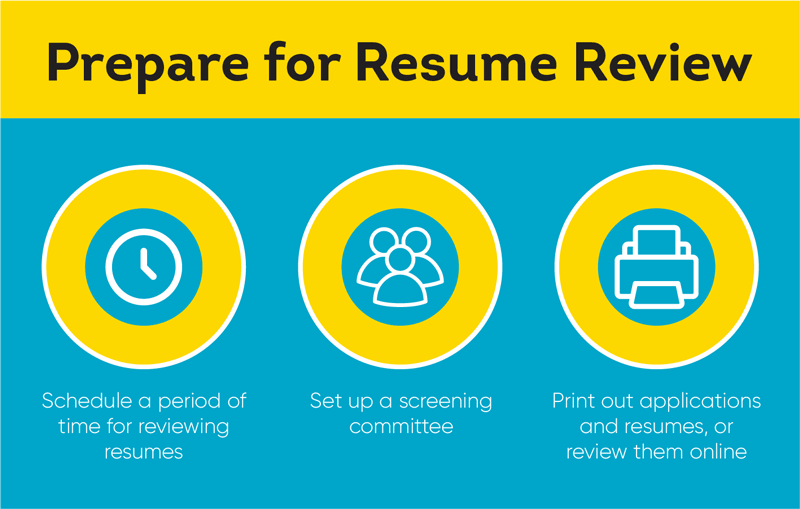The job candidate is sitting right across from you. You’re having to juggle skimming their resume while judging their character. At this stage of the hiring game, too many small businesses rely on their gut.
As a small business owner, it is crucial to hire productive, go-getters who can enhance your business and facilitate company growth. A great hiring decision may help bring in more revenue. A bad hire can wind up costing 30% of the individual’s first-year potential income according to the U.S. Department of Labor. If you are looking to fill a position in your small business, then you’ll need to be able to review resumes quickly and efficiently.
One study found that a typical hiring manager spent just an average of six seconds reviewing a resume. This may seem like an impossibly short amount of time, but by learning how to be a discerning reviewer, you can speed up the resume evaluation process.

Setting up a standard resume review process can help you spot great candidates from the start and help ensure you’re bringing in the right applicants for interviews. Check out this guide for resume review and learn how to spot key qualities of a good employee.
Before You Start
It’s wise to spend time crafting a well-designed job posting to attract the right candidates from the outset. A successful posting includes a job description that provides enough information about the position – but in an economical amount of words. Indeed.com data has shown that job descriptions between 700 to 2,000 characters get up to 30% more applications than posting with not enough (or too much) info.
Job Description Basics:
- Essential position responsibilities
- Qualifications and certifications
- Company mission, culture, and benefits
- To whom the position reports
- Salary range
- Job location
- Remote or in-house designation
- How the job fits into the company
In addition to a comprehensive job description, be sure to carefully describe your ideal candidate, so applicants have a basic understanding of how well their background complements the position.
Ideal Candidate Profile List:
- Desired key characteristics
- Necessary skills
- Level of experience
- Education
- Other factors (i.e. bilingual)
Outlining your dream candidate and noting job requirements will help you evaluate and compare candidates and can also serve as the basis for the job interview questions later on.
Tips to Prepare for Resume Review
After the job posting has gone live on job posting sites and your company website, the resumes will start to roll in. Once you’ve closed your application period, it’s time to assess the quality of your prospects.

Resume Prep Steps
- Schedule ample time to review resumes
- Set up a screening committee
- Only applicable if multiple people will review resumes
- Ensure all members of the committee have access to the job posting and resumes
- Print out applications and resumes or review them online
How to Evaluate a Resume
A well-crafted resume can demonstrate a candidate’s relevant experience, highlight germane accomplishments, convey seriousness about the position and help you filter out less-qualified applicants. But what should you be looking for?
1. Review Cover Letter
Consider asking for a cover letter in addition to a resume in your job posting. You’ll get a more in-depth insight into an applicant’s employment history and desire to work at your company. A well-written cover letter should provide more detailed information about a candidate’s qualifications and explain any gaps in employment.
Pro Tip: If you’ve asked for a cover letter and an applicant doesn’t bother to submit it, then it could be an indication that they aren’t all that passionate about your open position or they are just shotgunning resumes out.
While you’re reading cover letters, note overall attention to detail and how well it is customized to your organization and the position in question. Make note of the tone, grammar, and general organization.
Key items to look for in a cover letter:
- Customization to your company
- Summary of career trajectory and changes
- Explanation about how they are a good fit
- Professionalism
- Correct spelling and grammar
- Attention to detail

2. Scan Resume for Key Qualifications
At a glance, does the applicant fulfill the expectations, experience, and qualifications of your ideal hire? Do they have the right mix of hard and soft skills to complement the position, team, and company?
Key items to look for during the initial resume screening process:
- Easy-to-find qualifications
- Education
- Clean presentation
- Correct grammar
- Readability
- Technical certifications
- Keywords
You may want to filter resumes into piles: one with “must-have” qualifications – the minimum requirements for the job – and one with “preferred” qualifications – a higher level of experience or skill set that is ideal but not strictly necessary.
Examples of qualifications:
- Soft skills: communication, self-motivation, adaptability, etc.
- Hard skills: Java coding, paid search marketing, QuickBooks certification, etc.

3. Identify Quantifiable Results
A strong applicant will have facts to back up their resume claims. Soft skills are important and should be considered; however, results such as increasing total revenue, hitting a sales goal, or demonstrating a measurable growth in productivity are more impressive. Hard numbers show a hiring manager the job candidate’s potential for real results.
Key numbers to look for:
- Percentage increases
- Sales numbers
- Statistics
- Contributions
Examples of quantifiable results:
- % increase in profit
- % increase in page views
- % increase in user engagement
- Number of new clients
- Cost savings
- Sales revenue numbers
- Client retention rate
- Reduction of overtime costs
- Employee retention numbers

4. Assess Job Candidate’s Career Intent
Look at the candidate’s resume objective to determine why they’re looking for another job and how your role works with their long-term aim. Honing in on their desired career path can provide insight into whether or not the candidate is in it for the long haul.
Is the resume objective section specific to the job posting? Avoid candidates who make sweeping generalizations – they may not be as driven as an individual with specific goals in mind.
Key items in resume objective section:
- Summary of skills and experience
- Career history and growth
- Clear objective relevant to the job opening

5. Review Previous Employment
Assess your applicant’s previous employment, including place of work, tenure, and title held.
Key items in work history section:
- Dates of tenure at past employment
- Does the applicant have relevant work history?
- If yes, do they have the required experience?
- 6+ years for senior positions
- 3-5 years for mid-level positions
- 0-2 years for junior level
If the candidate doesn’t have the exact industry experience you were looking for, you may not want to write them off immediately. If an applicant has the skills you want or need but he or she comes from a different industry, that could prove valuable. Sometimes, hiring a bright talent and getting a fresh perspective can lead to out-of-the-box solutions and ideas.
Don’t stop at resume review when considering employment history. As noted in a CareerBuilder survey, 58% of hiring managers reported incorrect information on resumes with the most common inaccuracies being job title, job duties, and dates of employment. After reviewing an applicant’s most recent employment experience and contributions, consider verifying employment history by calling employer references to double-check that reported information is accurate.
Pro-tip: Pay attention to applicants who tend to stay at jobs for two or more years. These candidates may be less likely to job-hop.

6. Watch Out for Red Flags
While you should know what you want, you should also know what you don’t want.
Resumes may hold warning signs about a job applicant—but it is necessary to know what those red flags look like. If you discover anything related to the details below, you may want to consider a different candidate.
Resume Potential Red Flags:
- Unexplained employment gaps
- Failure to follow through with directions (lack of requested cover letter, resume sent to the wrong person)
- Failure to provide salary range (where legally permissible to ask for it)
- Spelling and grammar issues throughout resume (speaks to lack of attention to detail)
- Evidence of diminishing responsibility (was your candidate demoted at some point?)
- Career plateau or wrong direction (was your candidate at the same position for too long)
- Short-term employment at many jobs (could be a “job hopper” who might only stay temporarily)
- Multiple shifts in career paths (could be a lack of focus or intent)
- Lack of resume customization (candidate may not be as serious about the position as you hoped)

These are just a few of the issues you may see on an applicant’s resume. The examples above also demonstrate why a cover letter may be helpful: it gives an otherwise great candidate a chance to explain details such as a gap in employment or career change.
After Reviewing Resumes
Once you’ve finished reviewing resumes and selected top candidates, follow these steps:
Interview Applicants
Screen applicants with a phone interview before inviting them on-site. Compare answers between candidates and narrow down the pool, then schedule in-person interviews. As a reminder, you should always consult the laws applicable to your business and consider consulting an attorney to help you with confirming your responsibilities under applicable law – since this material is not legal advice and should not be construed as legal advice.
Interview Considerations:
- Open-ended questions that require more than a “yes” or “no” answer
- Situational questions
- Character questions
- Employment questions
- Cultural fit assessment
- Emotional intelligence, coachability, and temperament assessment
After you’ve interviewed potential hires and found the most promising individual, you have one last step to complete: vet your applicant with references and a background checks.
Vet Your Candidate with Background Checks and Reference Calls
While you may have a good idea of what to look for on a resume, you should always go one step further to verify the provided information.
Call References
It’s a good idea to ask for references. You’ll want to call their last employer, if feasible, and talk with the hiring manager to learn more about their performance. Asking about how they adapted to change, worked with others, met deadlines, and produced good work are areas to explore. Essentially, the small business owner will want to square up what is on the resume, what they heard from the candidate, and how they appraised the candidate’s potential with what the reference check is saying.
Employment background checks
A background check from ShareAble for Hires is an essential part of the hiring process. The entrepreneurial world moves fast, and Shareable for Hires understands that a small business needs to keep up with the pace while protecting its interests. A comprehensive background check helps by reducing your hiring risks.
Unfortunately, a traditional background check can take weeks for the results to come in, which may translate to lost profits for you and your business. Luckily, ShareAble for Hires can deliver credit, identity, and background reports with data from TransUnion in minutes.
- Credit checks give insight into financial responsibility
- Criminal records give you information on relevant criminal history
- Identity reports give you verification that who you’re screening is the person they say they are
Benefits for the job applicant
ShareAble ensures that the applicant’s personal information is not only shared with the prospective employer, but also with the applicant. It gives the applicant a way to quickly share pertinent information in a safe way and speeds up the hiring decision-making process.
- Makes employer-employee trust possible by reliably representing prospective employees to small businesses
- ShareAble process automatically sends employment screening reports to both screener and consumer
- By doing this, ShareAble for Hires adds transparency to the screening and hiring process
- This means that applicants can review exactly what an employer sees in the results of your background check
Payoff: Transparency in the screening process ensures that all applicants can safely and confidently share their personal information to land a new job faster and potentially start same day.
Benefits for small business
ShareAble is designed specifically to help SMB’s. When you are ready to screen your next great hire, ShareAble is ready to help expedite the process by delivering near instant background information, credit history, and identification reports. You get critical information that you need fast and it helps you hire staff on-the-spot.
- No delay - signup to transaction completion is quick
- No blocks - access to screening tools is fast
- No waiting - start now, no need to call to establish your account
- No requisites - removed back-office requirements that might prevent usage
- No hassle - All online, available 24/7, use on any device
Payoff: No waiting to transact, even if it is your first time. Other screening solutions can prevent access to background check tools based on superfluous factors, such as your tax responsibilities and accreditation. Not ShareAble.
Complete 3 simple steps to complete a transaction:
1) Create a free account
2) Send the screening request to the applicant
3) Applicant consents to share reports with the employer and authenticates their identity
So next time you think your next great employee is sitting across from you in an interview, ask them to share their background data via ShareAble for Hires and reach quicker, more confident hiring decisions.







